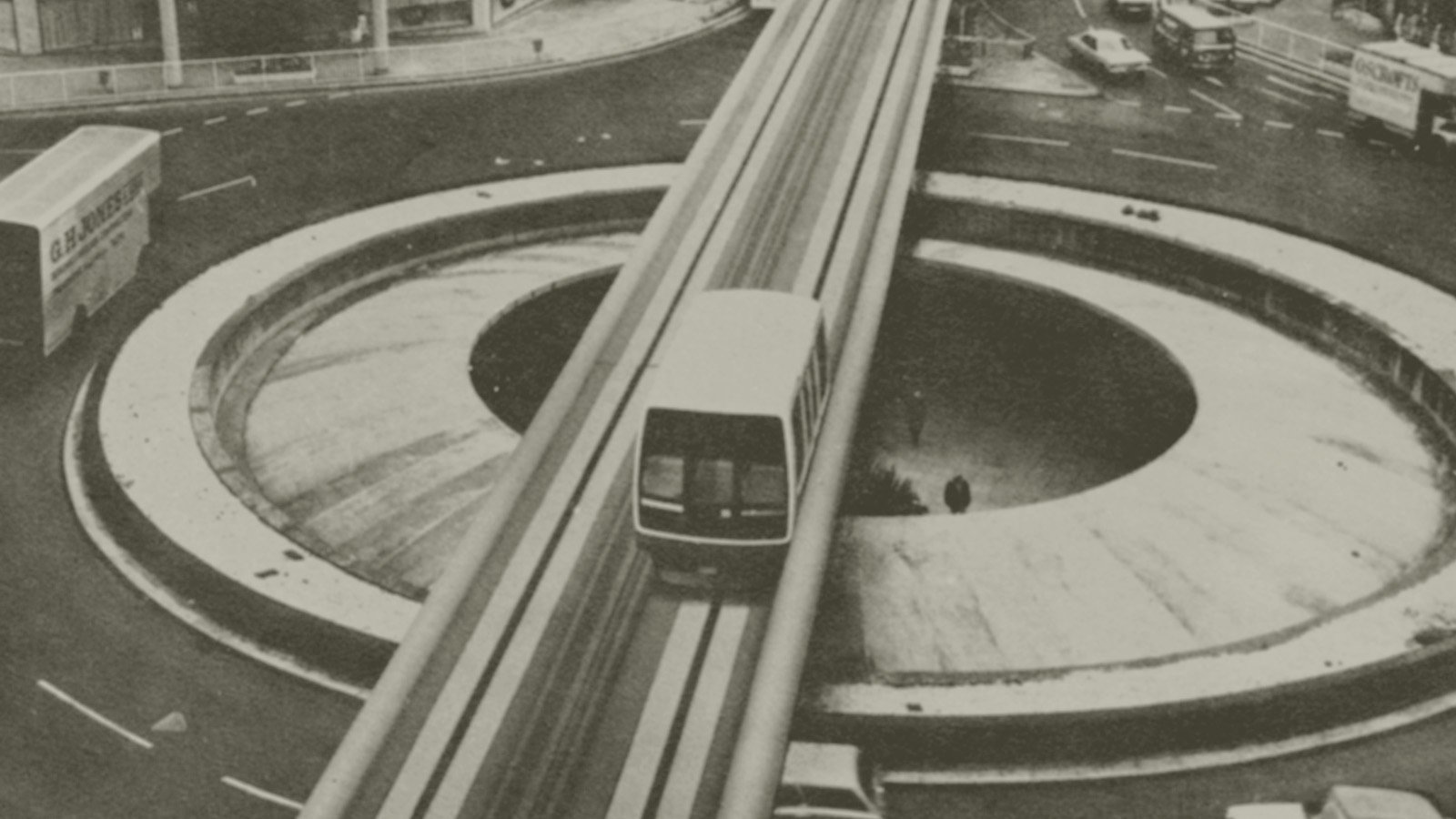Long before Supertram, Sheffield planned a Minitram monorail system.
Back in the 1970s, Sheffield Metropolitan District Council explored methods to better connect various parts of the city centre. The city’s public transportation system had become increasingly strained after the ‘old’ trams stopped running in 1960.
Combining local and national interests
Around the same time, the Government’s Transport and Road Research Laboratory were exploring a project aimed at improving metropolitan transport. Local and national interests conveniently merged.
Initial proposals included an extended minicab system with taxis getting their own ‘stations’ in and around the city. However, a political storm ensued around the intricacies of such a system. Arguments stemmed around locations and designs of the stations leading to planners abandoning the idea in favour of alternative schemes.
A fashion of the time saw a number of airports and expos served by ‘futuristic’ systems such as Monorails. Thinking such a scheme could work in metropolitan areas, the planners conducted a study to introduce similar in Sheffield.
The Sheffield Monorail exhibition at Cole Brothers
Two potential suppliers – EASAMs and Hawker Siddeley Dynamics – supplied concepts for the project. Architects Robert Matthew Johnson-Marshall were commissioned to compile preliminary designs.
The government simultaneously provided funding to British Rail to research the feasibility of a ‘Maglev’ (magnetic levitation) solution on the same route.
A resulting proposal was publicly exhibited on the third floor of Cole Brothers department store in 1974.
The system presented was Sheffield’s ‘Minitram’ monorail running on 2.5km of track.
Mocked-up photographs showed the tram running along familiar roads and models were displayed to give an idea of how the infrastructure would look. Promotional materials were created.
Shuttle service
Automated driverless carriages would be placed on elevated tracks running above existing streets (many of which have had traffic restrictions or been pedestrianised since).
Plans show the Minitram system running from Sheffield Midland Train Station to a terminus where the Moorfoot Building now stands. Essentially, the service would have replaced the incumbent ‘clipper’ bus.
The ‘shuttle’ route would have nine stops, taking a journey via Pond Street, Shude Hill, Haymarket, High Street, Fargate, Barkers Pool and The Moor.
Along the way the system would serve the ‘shopping spine’ of the city centre and popular destinations such as the City Hall, the Town Hall, Sheffield Cathedral and Castle Market.
One of the most iconic images from the exhibition is a mock-up of the Minitram passing over the infamous ‘Hole in the Road’ roundabout.
-
 Hole in the Road Sheffield Framed Art Print — A4 | Art by James (Exclusive)£35.00
Hole in the Road Sheffield Framed Art Print — A4 | Art by James (Exclusive)£35.00 -
 Hole in the Road Sheffield Art Print | Art by James (Exclusive)£20.00 – £50.00
Hole in the Road Sheffield Art Print | Art by James (Exclusive)£20.00 – £50.00 -
 Hole in the Road Sheffield Framed Art Print — A3 | Art by James (Exclusive)£45.00Rated 5.00 out of 5 based on 1 customer rating
Hole in the Road Sheffield Framed Art Print — A3 | Art by James (Exclusive)£45.00Rated 5.00 out of 5 based on 1 customer rating
Estimates showed the Sheffield Monorail would have had a peak capacity of 5,400 passengers per hour if running with three-train cars.
Plans included a possibility of extending the network to Hillsborough, Rotherham and through London Road to Heeley and beyond if the project was successful.
Government cancellation
Despite central government committing all the initial development costs, concerns grew that Sheffield City Council would inherit build costs. Friction built up between local and national stakeholders, and local residents began questioning the project.
On 22 May 1975 the Minister for Transport officially cancelled the proposals, citing excessive public expenditure and further development needed before such a system could come into public use.
It would take a further twenty years for plans to be revised into a suitable alternative, eventually taking shape in the form of South Yorkshire Supertram.
Beyond the Sheffield Monorail
Sheffield’s Minitram proposals caught the eye of several other boroughs though. Notably, Greater London Council were said to have been jealous that such a scheme should be proposed outside the capital, thus they commissioned a feasibility study to build a similar system in Croydon.
However, the only similar system eventually built in the UK was a smaller-scale Maglev solution in Birmingham, running between 1984-1995. The world’s first low-speed Maglev shuttle operated along a 600 metre route from Birmingham International Airport to Birmingham International Railway Station.
South Yorkshire Supertram
The South Yorkshire Supertram system eventually opened on 21 March 1994 but struggled to hit passenger number targets. International transport company Stagecoach bought out Supertram’s operating company in 1997 following poor performance.
Sheffield Monorail plan summary:
| Guideway (track) | 2.4km of double track 5km total length (including terminus loops) Elevated clearance: 5.1m at traffic crossings, 3.5m elsewhere |
| Stations | 9 stations Average spacing between stations of 300m Dwell time of 15 seconds |
| Vehicles | 25 (6 seated) capacity/car |
| Speed | 15-20km/hour (avg.) terminal to terminal 60km/hour cruise speed |
| Operations | Peak: Three-car trains, 5,400 passengers/hour Off-peak: Single vehicles, 180 seats/hour |
What are your thoughts on the aborted Sheffield Monorail plans? Have your say in the comments below!
Discover the very best of the Steel City with The Sheffield Guide Newsletter!
Sign up now to receive occasional updates from The Sheffield Guide. All the latest Steel City information direct to your inbox!
Free to subscribe. No-spam guarantee. Unsubscribe at any time.
Founder and editor of The Sheffield Guide. A lifelong Sheffielder with a local pride that lovingly crafts each and every piece created. Discover the very best of the Steel City with The Sheffield Guide.




































![[SHF] Launches new Sheffield fashion collection](https://i0.wp.com/www.sheffieldguide.blog/wp-content/uploads/2021/01/SHF-Fashion-Collection-1.jpg?resize=100%2C100&ssl=1)













Pingback: Diversionary Schemes – Cambridge Area Bus Users